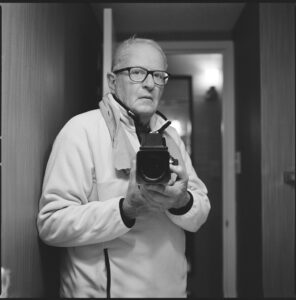Born in Brooklyn, New York, on November 24, 1940, Arthur Tress began his first camera work as a teenager in the surreal neighborhood of Coney Island where he spent hours exploring the decaying amusement parks. Later, during five years of world travel, mostly in Asia and Africa, he developed an interest in ethnographical photography that eventually led him to his first professional assignment as a U.S. government photographer recording the endangered folk cultures of Appalachia.
Seeing the destructive results of corporate resource extraction, Tress began to use his camera to raise environmental awareness about the economic and human costs of pollution. Focusing on New York City, he began to photograph the neglected fringes of the urban waterfront with a straight documentary approach. This gradually evolved into a more personal mode of “magic realism” combining improvised elements of actual life with stage fantasy that became his hallmark style of directorial fabrication. In the late 1960s Tress was inspired to do a series based upon children’s dreams that combined his interests in ritual ceremony, Jungian archetypes, and social allegory. Later bodies of work dealing with the hidden dramas of adult relationships and the reenactments of male homosexual desire evolved from this primarily theatrical approach.
Beginning in the early 1980s, Tress began shooting in color, creating room-sized painted sculptural installations out of found medical equipment in an abandoned hospital on New York’s Welfare Island. This led to a smaller scale exploration of narrative still life within a children’s toy theater and a portable nineteenth-century aquarium.
Around 2002, Tress returned to gelatin silver, exploring more formalist themes in the style of mid- century modernism, often combining a spontaneous shooting style with a constructivist’s sense of architectural composition and abstract shape. In addition to images of California skateboard parks, his recent work includes the round images of the series Planets and the diamond-shaped images of Pointers.
Selected Arthur Tress Books and Publications
- Open Space in the Inner City: Ecology and the Urban Environment. New York: New York State Council on the Arts, 1971.
- Arthur Tress: The Dream Collector. Text by John Minahan. Richmond: Westover, 1972, New York: Avon, 1974.
- Shadow. A Novel in Photographs. New York: Avon, 1975
- Theater of the Mind. Text by Duane Michaels, Michel Tournier and A.D. Coleman. Dobbs Ferry: Morgan and Morgan, 1976.
- Reves. Text by Michel Tournier. Brussels: Complexe, 1979.
- Talisman. Edited by Marco Livingstone. Oxford: Museum of Modern Art, Oxford, 1986.
- The Teapot Opera. Photographs and text by Arthur Tress. Goro International, 1986, Abbeville, 1988.
- Male of the Species: Four Decades of Photography by Arthur Tress. Text by Michale Tournier. Fotofactory, 1999.
- Fish Tank Sonata. Bulfinch, 2000.
- Arthur Tress: Fantastic Voyage: Photographs 1956-2000. Bulfinch, 2001.
- Memories. Photographs by Arthur Tress, Poems by Guillaume Apollinaire. 21st, 2003
- Arthur Tress: Facing Up. Top Choice, 2004.
- Planets (Portfolio Book). Lodima Press, 2007.
- Arthur Tress San Francisco 1964 by James Ganz. Prestel USA, 2012.
- Arthur Tress: Transréalités. France: Contrejour. 2013.
- Egypt 1963 One. Southport, England: Café Royal, 2014.
- Egypt 1963 Two. Southport, England: Café Royal, 2014.
- The Circle of The Orange Rubber Traffic Cone, Pot Holder, 2019.
